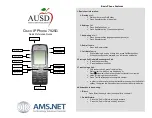
P
UB
42004-438A
300
S
ERIES
E
MERGENCY
T
ELEPHONE
M
ANUAL
P
AGE
2 of 44
f:\standard ioms - current release\42004 instr. manuals\42004-438a.doc
02/11
The
EMERGENCY
push button on each emergency telephone can be programmed to dial three different
telephone numbers. These include a primary telephone number and two “rollover” telephone numbers.
In the event an emergency call cannot connect to the primary telephone number (i.e., a busy signal or no
answer), the emergency telephone will automatically dial the first rollover number. If the first rollover
number is busy or no answer, the telephone will automatically dial the second rollover telephone number.
All RED ALERT™ Emergency Telephones are line-powered and can be connected to any of the
following networks:
•
Central Office (C.O.) line to the Public Switched Telephone Network (PSTN)
•
24 V dc or 48 V dc analog station port of a Private Branch Exchange (PBX), Private Automatic
Branch Exchange (PABX), or Key Service Unit (KSU).
N
OTE
:
Connection to pay telephone extensions or shared service (party) lines should be avoided.
Each telephone requires a minimum line current of 24 mA for proper operation. For operation below
−
4º F (
−
20° C), GAI-Tronics offers an Extreme Cold Weather Option that includes a plug-in power
supply (120 V ac required). This option will allow operation to
−
40° C.
The RED ALERT™ Emergency Telephones provide the flexibility to address a diverse range of
applications. A wide variety of functions can be achieved by altering the configuration data stored in the
telephone’s non-volatile memory. These configuration options include:
•
Pre-programmed auto-dial telephone numbers
•
Call termination method (automatic or manual)
•
Maximum call duration
•
Answering options
Values for these functions are initially programmed during factory testing. These settings can be changed
remotely from a touch-tone telephone, manually (with an integral or portable keypad), or via TMA.
Emergency auto-dial telephone numbers are typically programmed in accordance with existing security
plans. Most applications will require very little additional programming, as factory defaults are typically
sufficient.




































